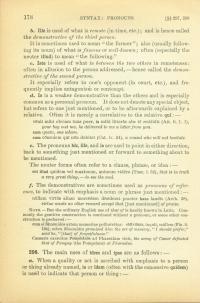296. Demonstrative pronouns are used either adjectively or substantively.
- As adjectives, they follow the rules for the agreement of adjectives and are called Adjective Pronouns or Pronominal Adjectives (§§ 286 - 287).
hōc proeliō factō
after this battle was fought (this battle having been fought)eōdem proeliō
in the same battleex eīs aedificiīs
out of those buildings - As substantives, they are equivalent to personal pronouns. This use is regular in the oblique cases, especially of is.
Caesar et exercitus êius
Cæsar and his army (not suus)BUT
Caesar exercitum suum dīmīsit.
Cæsar disbanded his [own] army.]sī obsidēs ab eīs dentur (B. G. 1.14)
if hostages should be given by them (persons just spoken of)Hī sunt extrā prōvinciam trāns Rhodanum prīmī. (id. 1.10)
They (those just mentioned) are the first [inhabitants] across the Rhone.Ille minimum propter adulēscentiam poterat. (id. 1.20)
He had very little power, on account of his youth.
a. An adjective pronoun usually agrees with an appositive or predicate noun, if there be one, rather than with the word to which it refers (cf. § 306).
Hīc locus est ūnus quō perfugiant; hīc portus, haec arx, haec āra sociōrum (Verr. 5.126)
This is the only place to which they can flee for refuge; this is the haven, this the citadel, this the altar of the allies.
Rērum caput hōc erat, hīc fōns (Hor. Ep. 1.17.45)
This was the head of things, this the source.
Eam sapientiam interpretantur quam adhūc mortālis nēmō est cōnsecūtus [for id . . . quod] (Lael. 18)
They explain that [thing] to be wisdom which no man ever yet attained.
297. The main uses of hīc, ille, iste, and is are the following.
a. Hīc is used of what is near the speaker (in time, place, or thought). It is hence called the demonstrative of the 1st person.
It is sometimes used of the speaker himself; sometimes for “the latter” of two persons or things mentioned in speech or writing; more rarely for “the former,” when that, though more remote on the written page , is nearer the speaker in time, place, or thought. Often it refers to that which has just been mentioned.
b. Ille is used of what is remote (in time, etc.); and is hence called the demonstrative of the 3rd person. It is sometimes used to mean “the former”; also (usually following its noun) of what is famous or well-known; often (especially the neuter illud) to mean “the following.”
c. Iste is used of what is between the two others in remoteness: often in allusion to the person addressed—hence called the demonstrative of the 2nd person. It especially refers to one's opponent (in court, etc.), and frequently implies antagonism or contempt.
d. Is is a weaker demonstrative than the others and is especially common as a personal pronoun. It does not denote any special object, but refers to one just mentioned, or to be afterwards explained by a relative. Often it is merely a correlative to the relative quī.
Vēnit mihi obviam tuus puer, is mihi litterās abs tē reddidit. (Att. 2.1.1)
Your boy met me, he delivered to me a letter from you.
eum quem
one whom
eum cōnsulem quī nōn dubitet (Cat. 4.24)
a consul who will not hesitate
e.The pronouns hīc, ille, and is are used to point in either direction, back to something just mentioned or forward to something about to be mentioned.
f. The neuter forms often refer to a clause, phrase, or idea.
Est illud quidem vel maximum, animum vidēre. (Tusc. 1.52)
That is in truth a very great thing—to see the soul.
The demonstratives are sometimes used as pronouns of reference, to indicate with emphasis a noun or phrase just mentioned.
Nūllam virtūs aliam mercēdem dēsīderat praeter hanc laudis. (Arch. 28)
Virtue wants no other reward except that [just mentioned] of praise.
Note— But the ordinary English use of that of is hardly known in Latin. Commonly the Genitive construction is continued without a pronoun, or some other construction is preferred.
Cum eī Simōnidēs artem memoriae pollicērētur: oblīviōnis, inquit, māllem. (Fin. 2.104)
When Simonides promised him the art of memory, “I should prefer,” he said, “[that] of forgetfulness.”
Caesaris exercitus Pompêiānōs ad Pharsālum vīcit.
The army of Cæsar defeated that of Pompey (the Pompeians) at Pharsalus.
298. The main uses of īdem and ipse are as follows.
a. When a quality or act is ascribed with emphasis to a person or thing already named, is or īdem (often with the concessive quidem) is used to indicate that person or thing.
per ūnu servum et eum ex gladiātōriō lūdō (Att. 1.16.5)
by means of a single slave, and that too one from the gladiatorial school
vincula, et ea sempiterna (Cat. 4.7)
imprisonment, and that perpetual
Ti. Gracchus rēgnum occupāre cōnātus est, vel rēgnāvit is quidem paucōs mēnsīs. (Lael. 41)
Tiberius Gracchus tried to usurp royal power, or rather he actually reigned a few months.
Note— So rarely with ille.
nunc dextrā ingemināns ictūs, nunc ille sinistrā (Aen. 5.457)
now dealing redoubled blows with his right hand, now (he) with his left
In imitation of the Homeric ὅ γε: cf. Aen. 5.334; 9.796.]
b. Idem, the same, is often used where the English requires an adverb or adverbial phrase (also, too, yet, at the same time).
ōrātiō splendida et grandis et eadem in prīmīs facēta (Brut. 273)
an oration, brilliant, able, and very witty too
Cum [haec] dīcat, negat īdem esse in Deō grātiam. (N. D. 1.121)
When he says this, he denies also that there is mercy with God. (he, the same man)
Note— This is really the same use as in a. above, but in this case the pronoun cannot be represented by a pronoun in English.
c. The intensive ipse (self) is used with any of the other pronouns, with a noun, or with a temporal adverb for the sake of emphasis.
Turpe mihi ipsī vidēbātur (Phil. 1.9)
Even to me (to me myself) it seemed disgraceful.
id ipsum
that very thing
quod ipsum
which of itself alone
in eum ipsum locum
to that very place
tum ipsum (Off. 2.60)
at that very time.
Note 1— The emphasis of ipse is often expressed in English by just, very, mere, etc.
Note 2— In English, the pronouns himself etc. are used both intensively (as, he will come himself) and reflexively (as, he will kill himself). In Latin the former would be translated by ipse, the latter by sē or sēsē.
d. Ipse is often used alone, substantively, as follows.
- As an emphatic pronoun of the third person.
idque reī pūblicae praeclārum, ipsīs glōriōsum (Phil. 2.27)
and this was splendid for the state, glorious for themselvesomnēs bonī quantum in ipsīs fuit (id. 2.29)
all good men so far as was in their power (in themselves)Dī capitī ipsīus generīque reservent (Aen. 8.484)
May the gods hold in reserve [such a fate] to fall on his own and his son-in-law's head. - To emphasize an omitted subject of the first or second person.
vōbīscum ipsī recordāminī (Phil. 2.1)
remember in your own minds (yourselves with yourselves) - To distinguish the principal personage from subordinate persons.
Ipse dīxit (cf. αὐτὸς ἔφα)
He (the Master) said it.Nōmentānus erat super ipsum. (Hor. S. 2.8.23)
Nomentanus was above [the host] himself [at table].
e. Ipse is often (is rarely) used instead of a reflexive (see § 300.b).
f. Ipse usually agrees with the subject, even when the real emphasis in English is on a reflexive in the predicate.
Mē ipse cōnsōlor. (Lael. 10)
I console myself. [Not mē ipsum, as the English would lead us to expect.]




